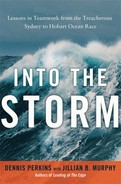40
![]()
Tenacious Creativity
Strategy #10
Never give up—there's always another move.
Teams that succeed in the face of extreme adversity share two complementary characteristics: They persevere in the face of enormous odds, and they devise imaginative solutions to problems. These two elements—determination and creativity under pressure—make a team unstoppable.
All the Ramblers brought their own sense of resolve to the team. For Ed Psaltis, his determination started in sports:
I played rugby football and was reasonably good. I might not have had as much talent as my other schoolmates, but I had a lot of tenacity. I never gave up. If we lost a game, I came back twice as hard the next time. Tenacity is something I've always had in anything I've done in life—business or sports. I don't give up. I keep at it until I get to the goal.1
Individual tenacity was important, but it was the combined effort of the team that enabled them to not only persist but also to innovate in the most stressful and life-threatening situations.
In the ’94 Hobart, when Nuzulu was rolled and lost its mainsail, things seemed truly hopeless. The Ramblers were disappointed and demoralized. They had come close to drowning, and they had no chance of winning the race. It would have been easy to pull out.
Yet they came together as a team, and they found the determination to persevere. Mix Bencsik created a catalytic moment with his resolute statement: “Don't even think about pulling out of this race. We have gotten this far and we have to finish the race. If we do, we will remember this as one of our proudest moments.”
The race became a milestone for the Ramblers—but only because they were able to combine tenacity with creativity. Arthur Psaltis recalls:
We tried a number of different jury-rigged systems that didn't work. But the solution was staring us in the face: We could create a series of knots that we could put into the mast, and then tie some knots onto the sail. Once we'd done it, it was obvious how it could work. But it took hours of thinking to come up with the solution, and we were going sideways all that time. It looked hopeless, but we really wanted to finish. By constantly thinking about what we needed to do, the solution finally came.2
The solution did emerge, but it didn't come from a think tank in Silicon Valley. It came from a group of guys who had just recovered from a capsize. It came from their determination to devise a way to finish a race they knew they couldn't win. And it was one of their proudest moments.
The unyielding tenacity that the Ramblers demonstrated in 1994 stayed with them through other daunting times. It was there in 1998, when they encountered hurricane force winds and walls of water twice the size of their boat. It was there when they needed to devise a crew management system to survive the storm. And it was there near the end of the race, when they lost their navigation instruments and were fighting dying winds in the Derwent River.
The same spark of creativity that had enabled them to devise a makeshift sail on Nuzulu helped them on the Derwent. Improvising once again, the Ramblers created a makeshift wind instrument by breaking a cassette and fastening the tape to the mast so they could judge the wind direction. It wasn't elegant—but it worked.
The Ramblers’ ability to persevere has been displayed on many occasions, and one of the most memorable examples came in a 2007 race. On a pitch-black night, with a hard southerly wind and big seas, their mainsail burst. They could have turned around—numerous other boats did. But surrender is not a word in the team's vocabulary. The Ramblers sailed on through the night to Flinders Island, turned around, and made it home, completing the “out and back” race that was part of the Blue Water Point Score series.
Because conditions were so difficult and so many boats retired, even with their small storm sail the Ramblers still finished in third place. When the season was over, AFR Midnight Rambler had won the coveted Blue Water Point Score by two points. If they had retired, they wouldn't have won the series.
Tom Barker—another newcomer to the team—shared his observations on the 2007 competition:
That race was a good metaphor for the crew's approach to racing. Even when conditions are tough and everything is stacked against us, we find an answer to make our way through. Finishing the race was important and it is a testament to the crew. When those other boats turned around and retired and headed home, we were still out there.3
This strategy, then, is a state of mind—a set of lenses for viewing the world. It is grounded in the belief that the team will succeed, but it is much more than stubborn persistence. It is based in reality. If a solution isn't working, then it's time to try something else.
The Ramblers—and other teams that succeed at The Edge—maintain an unshakable belief that somehow, somewhere, there must be a path that will get them to the finish line. As Ed Psaltis observed, “When the chips are really down, our mentality is—never give up. There is always another move, and always another option.”
Navigation Points
1. Does your team persevere in the face of adversity?
2. When faced with setbacks, is your team able to think creatively and develop innovative solutions?
3. Are there “proud moments” in the history of your team—times when the team has come together and exhibited tenacious creativity?
4. Do you draw inspiration from stories of other teams that have worked together to overcome daunting challenges? Does your team share stories as a source of inspiration?
